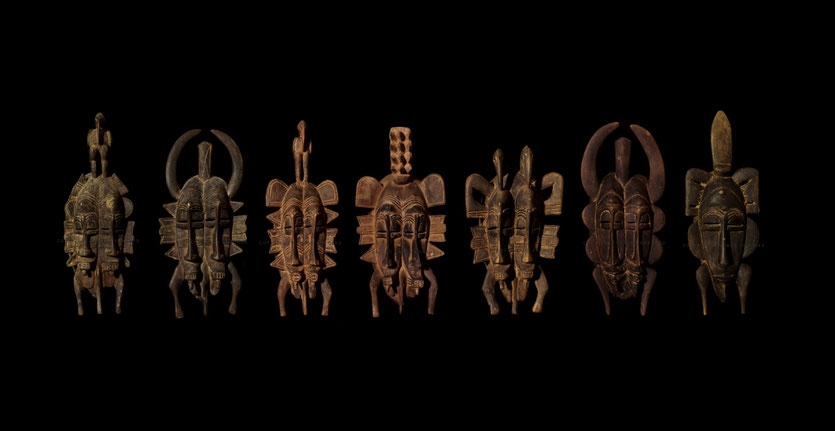
Over the years of collecting Kpelié masks of the Senufo tribe, I had the opportunity to see a huge number of masks of certain carvers. Sometimes it is easy to identify or determine the soucre of origin, sometimes a mask or statue made by a known carver is completely different to an object made from the same hand. Keeping in mind that some carvers worked for more than 60 years certain styles, shapes and proportions evolve and can change fundamentally.
In their lifetime Senufo carvers could be very productive. More than 1.000 objects from a small statue up to a large piece of furniture made by just one man is not uncommon, keeping in mind that the guys started carving at an age of 12 or even younger. By collecting a number of pieces from one carver over the years, you learn to see the development, observe the change of the artistic awareness, exposing the strengths and the weaknesses, pointing out the own handwriting and character.
Yalourga Soro was a Koulé from Ganaoni. His available dates of birth and death can not be accurately be determined. He was the same generation as Songuifolo Silué (1914-1986). Yalourga was very productive in a long lifetime. It can not be verified if Yalourga did learn directly as a student, but he provably was influenced by Sabariko Koné in his figurative statues (read my article: The Sabariko-Koné-Standard). Yalourga worked in the classic Ouézomon-style, but also, like Songuifolo Silué, in a pure and reduced style later in his lifetime.
A larger number of Tugubele couples (as separate male and female statue or male and female Tugubele are fixed together on a base) are known. They all show differences in their faces. Every Senufo carver does focus especially on the faces and heads to show that the statues belong together as a couple and to show that they have the same spiritual power. But this "weak point" in the creative work of Yalourga Soro becomes a character and a distinctive feature. His notion and conception for the shape of a body and body volume is deformed. One horse rider statue is known where the horse does look like anything else but not like a horse.
His double faced Kpelié mask stands in complete opposite to this understanding of shape and proportion. There are only six other Senufo carvers in this archive, where it is documentated, that they carved the double faced Kpelié (Bakari Coulibaly from Dickodougou, Ziehouo Coulibaly from Korhogo, Wahana Dairassouba from Tiogo, Nono Koné from Tiogo, Zanga Konaté from Blessegué and Doh Soro from Djemntene), but the masks from Yalourga Soro are the most precise masks when it comes to the symmetry of both faces. And, from my point of view, I can not name another carver who produced that many double faced masks (just one of the seven masks in my collection does have a single face).
The Yêchikpleyégué (Senufo name for the doublefaced Kpelié) is danced on public celebrations when twins are born. Everyone in the village is allowed to see this mask dancing and entertaining. Explanations about the doublefaced Kpelié in literature vary. Burkhard Gottschalk describes a bisexual symbolism in these masks, but the Senufo do not differenciate between sexual orientations. Karl-Heinz Krieg did document in several interviews with the carvers, that it is a sign of an intelligent sculpturer that he can carve two faces. It is like what we call a "Geniestreich" in Germany, an exception, only a very talented carver is able to do. In conversations I held, the answers in chorus where that the Yêchikpleyégué is danced to celebrate the birth of twins and that the spirits have two faces to give power and support the life of the new born ones.
For sure it is to say, that Yalourga's strength is the doublefaced Kpelié. In general it can be said, that his masks are nearly miniature like and tiny according to masks of the same genre of the other carvers. Comparing his masks in an own overview, their different stages of development are interesting to look at. He always carved with all the traditional features of a Kpelié, also named as Ouézomon-style. But, like Songuifolo Silué, Yalourga developed his own pure style in his masks, but not in his statues. The decoration elements are plain in these masks and not decorated with rills or carved hatchings. Obviously this reduced style is of importance when a carver is getting older and his eyesight gets weary.
Also a very characteristic feature of his work is the finish. Nearly all his masks show a greasy surface. He treated his masks with Karité butter. So the overview of these authentic masks does show certain stages of usage and patina. Some masks are completely covered with the black lye treatment, some have a crusty surface, other masks are like sanded, and the very old mask of Yalourga (first one on the left) does even show natural red Pigments, persumibly extracted from a plant.
I really would like to find out more about this interesting Senufo carver. Relatives, who still live in the area of Ganaoni, don't want to provide any information about Yalourga Soro for whatever reason.
Find more objetcs and information about Yalourga Soro in his profile:

